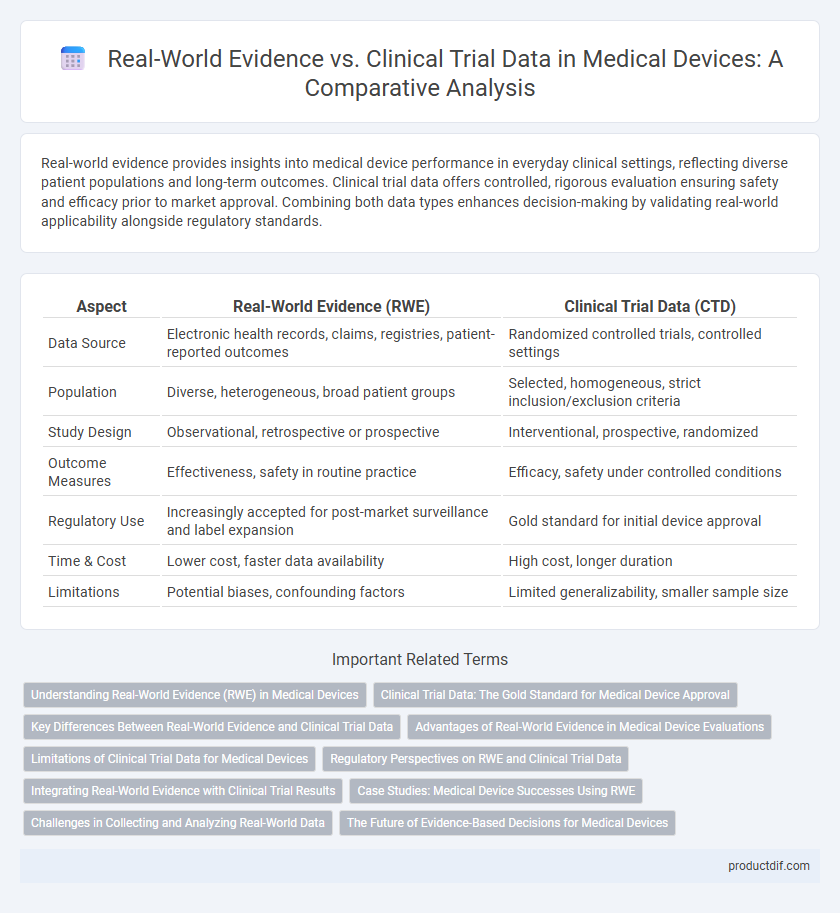Real-world evidence provides insights into medical device performance in everyday clinical settings, reflecting diverse patient populations and long-term outcomes. Clinical trial data offers controlled, rigorous evaluation ensuring safety and efficacy prior to market approval. Combining both data types enhances decision-making by validating real-world applicability alongside regulatory standards.
Table of Comparison
| Aspect | Real-World Evidence (RWE) | Clinical Trial Data (CTD) |
|---|---|---|
| Data Source | Electronic health records, claims, registries, patient-reported outcomes | Randomized controlled trials, controlled settings |
| Population | Diverse, heterogeneous, broad patient groups | Selected, homogeneous, strict inclusion/exclusion criteria |
| Study Design | Observational, retrospective or prospective | Interventional, prospective, randomized |
| Outcome Measures | Effectiveness, safety in routine practice | Efficacy, safety under controlled conditions |
| Regulatory Use | Increasingly accepted for post-market surveillance and label expansion | Gold standard for initial device approval |
| Time & Cost | Lower cost, faster data availability | High cost, longer duration |
| Limitations | Potential biases, confounding factors | Limited generalizability, smaller sample size |
Understanding Real-World Evidence (RWE) in Medical Devices
Real-world evidence (RWE) in medical devices represents data gathered from routine clinical practice, including registries, electronic health records, and patient-reported outcomes, offering insights beyond controlled clinical trials. Unlike clinical trial data, which is collected under strictly regulated environments with defined protocols and patient criteria, RWE reflects the performance and safety of medical devices in diverse populations and real-world settings. Incorporating RWE enhances regulatory decision-making, post-market surveillance, and personalized device optimization by capturing long-term usage patterns and rare adverse events.
Clinical Trial Data: The Gold Standard for Medical Device Approval
Clinical trial data remains the gold standard for medical device approval due to its rigorous methodology, controlled environments, and randomized participant allocation ensuring high internal validity. Regulatory agencies like the FDA and EMA prioritize clinical trial results to assess safety and efficacy before market authorization. Although real-world evidence complements post-market surveillance, clinical trials provide the definitive, statistically robust data required for initial device approval.
Key Differences Between Real-World Evidence and Clinical Trial Data
Real-world evidence (RWE) derives from data collected outside controlled clinical trials, such as electronic health records, patient registries, and insurance claims, reflecting diverse patient populations and routine clinical settings. Clinical trial data originates from carefully controlled environments with strict protocols, randomized participant selection, and standardized interventions to ensure internal validity and minimize bias. Key differences lie in the generalizability of RWE, which captures broader patient variability and long-term outcomes, versus the rigorous control and randomization in clinical trials that provide high accuracy for efficacy and safety assessments.
Advantages of Real-World Evidence in Medical Device Evaluations
Real-world evidence (RWE) provides comprehensive insights into medical device performance by capturing data from diverse patient populations and routine clinical settings, enhancing external validity. Unlike clinical trial data, RWE supports long-term safety and effectiveness monitoring, allowing for adaptive regulatory decisions and accelerated innovation cycles. Integration of RWE reduces costs and time associated with traditional trials while enabling personalized treatment assessment and post-market surveillance.
Limitations of Clinical Trial Data for Medical Devices
Clinical trial data for medical devices often face limitations such as restricted sample sizes and controlled environments that do not fully represent real-world patient populations or usage conditions. This can result in gaps in safety and efficacy information, especially for long-term or rare adverse events. Real-world evidence supplements these gaps by providing more comprehensive data from diverse patient experiences in routine clinical practice.
Regulatory Perspectives on RWE and Clinical Trial Data
Regulatory agencies increasingly recognize real-world evidence (RWE) as a valuable complement to clinical trial data in evaluating medical device safety and effectiveness. While randomized controlled trials (RCTs) remain the gold standard for initial approval, RWE from post-market surveillance and patient registries supports ongoing risk assessment and label expansions. Agencies such as the FDA and EMA provide specific guidelines to integrate RWE into regulatory submissions, emphasizing data quality, relevance, and methodological rigor.
Integrating Real-World Evidence with Clinical Trial Results
Integrating real-world evidence (RWE) with clinical trial data enhances medical device evaluations by providing comprehensive safety and effectiveness insights across diverse patient populations. RWE captures long-term outcomes and real-life device performance, complementing controlled clinical trial results that focus on efficacy under specific conditions. Combining these data sources supports regulatory decisions, post-market surveillance, and personalized treatment strategies in medical device innovation.
Case Studies: Medical Device Successes Using RWE
Case studies highlight that real-world evidence (RWE) offers critical insights into medical device performance across diverse patient populations beyond the controlled parameters of clinical trials. Examples such as the successful post-market surveillance of implantable cardioverter defibrillators demonstrate improved safety profiles and adaptive device modifications based on RWE analytics. Integrating RWE with traditional clinical trial data enhances regulatory decision-making and supports personalized treatment strategies for medical devices.
Challenges in Collecting and Analyzing Real-World Data
Challenges in collecting and analyzing real-world data (RWD) for medical devices include data heterogeneity, incomplete patient records, and variability in data quality across sources such as electronic health records, registries, and claims databases. Ensuring data standardization and accuracy is critical to deriving reliable real-world evidence (RWE), while addressing patient privacy and regulatory compliance remains complex. Advanced analytics and machine learning techniques are increasingly required to interpret large, unstructured datasets and mitigate biases inherent in observational data.
The Future of Evidence-Based Decisions for Medical Devices
Real-world evidence (RWE) offers comprehensive data derived from diverse patient populations, providing insights on long-term safety and effectiveness of medical devices beyond controlled clinical trial settings. Clinical trial data remain essential for initial regulatory approval due to their rigorous methodology and controlled environments, but RWE complements these findings by reflecting device performance in routine clinical practice. The future of evidence-based decisions will increasingly rely on integrating RWE with clinical trial data to enhance regulatory evaluations, post-market surveillance, and personalized patient care strategies for medical devices.
Real-world evidence vs Clinical trial data Infographic

 productdif.com
productdif.com